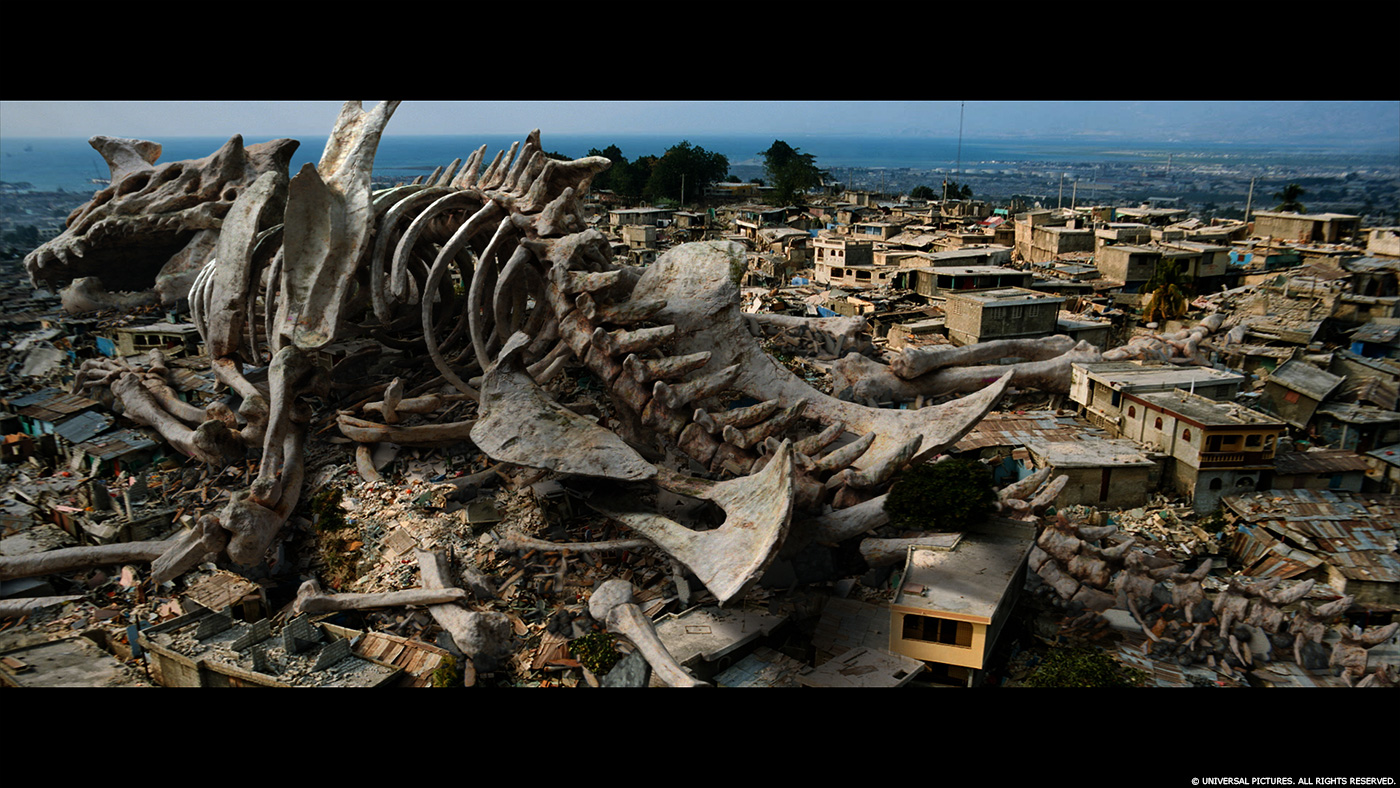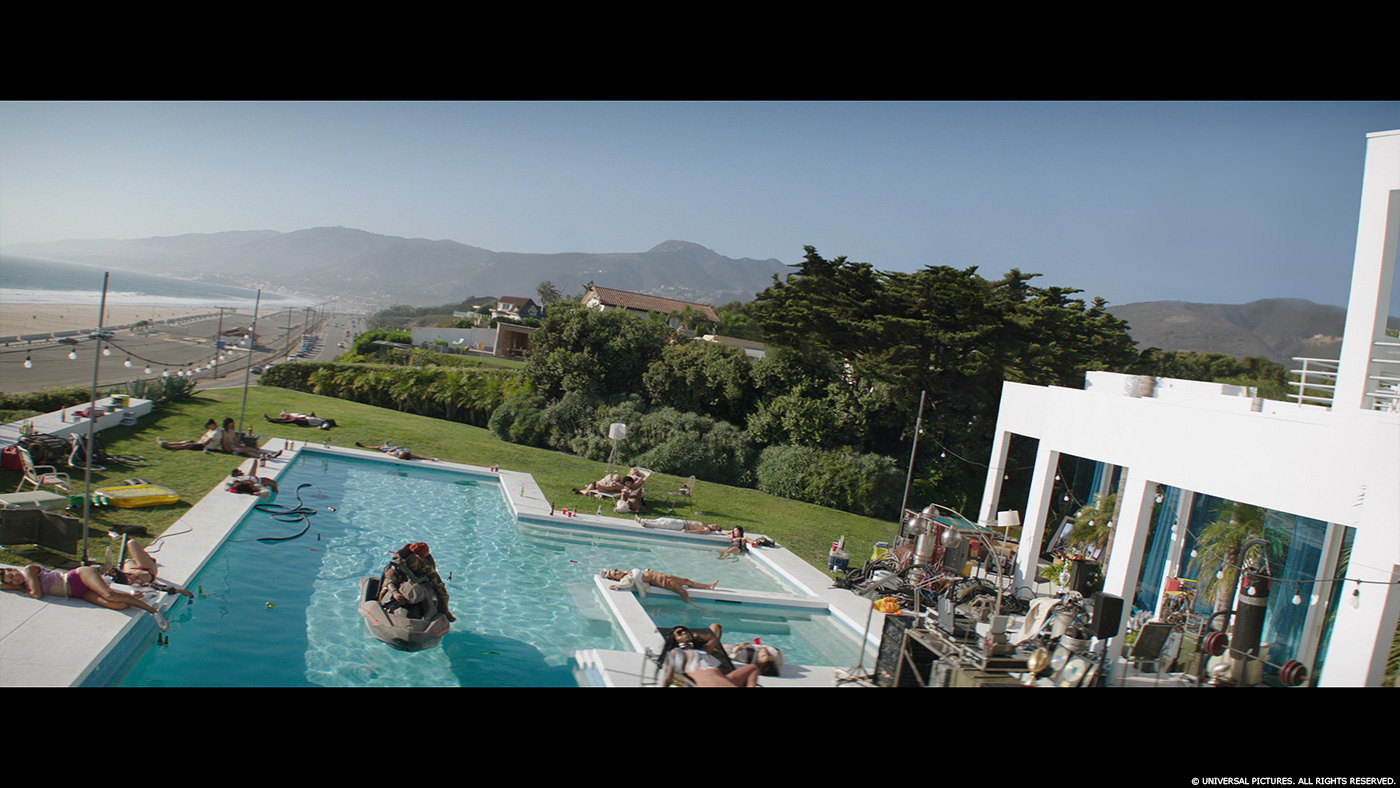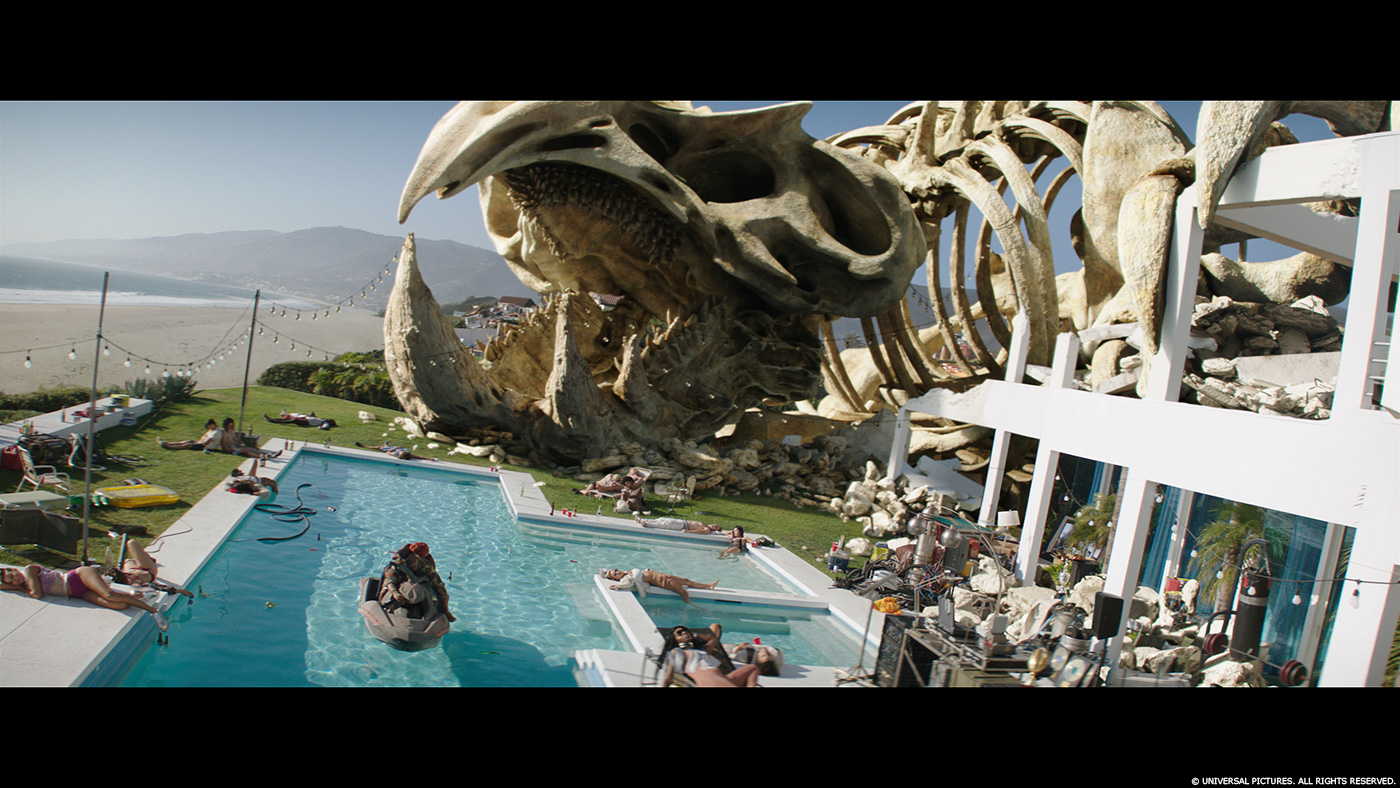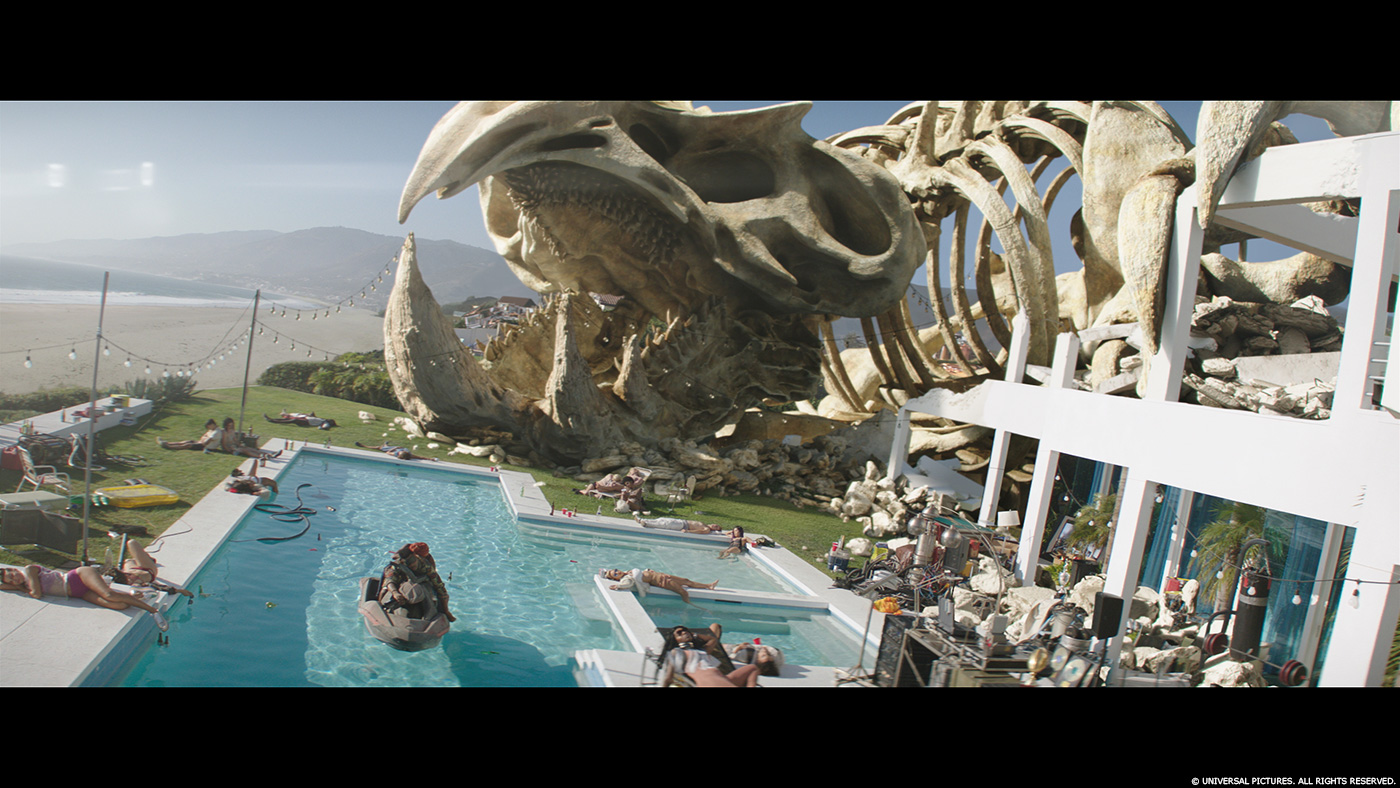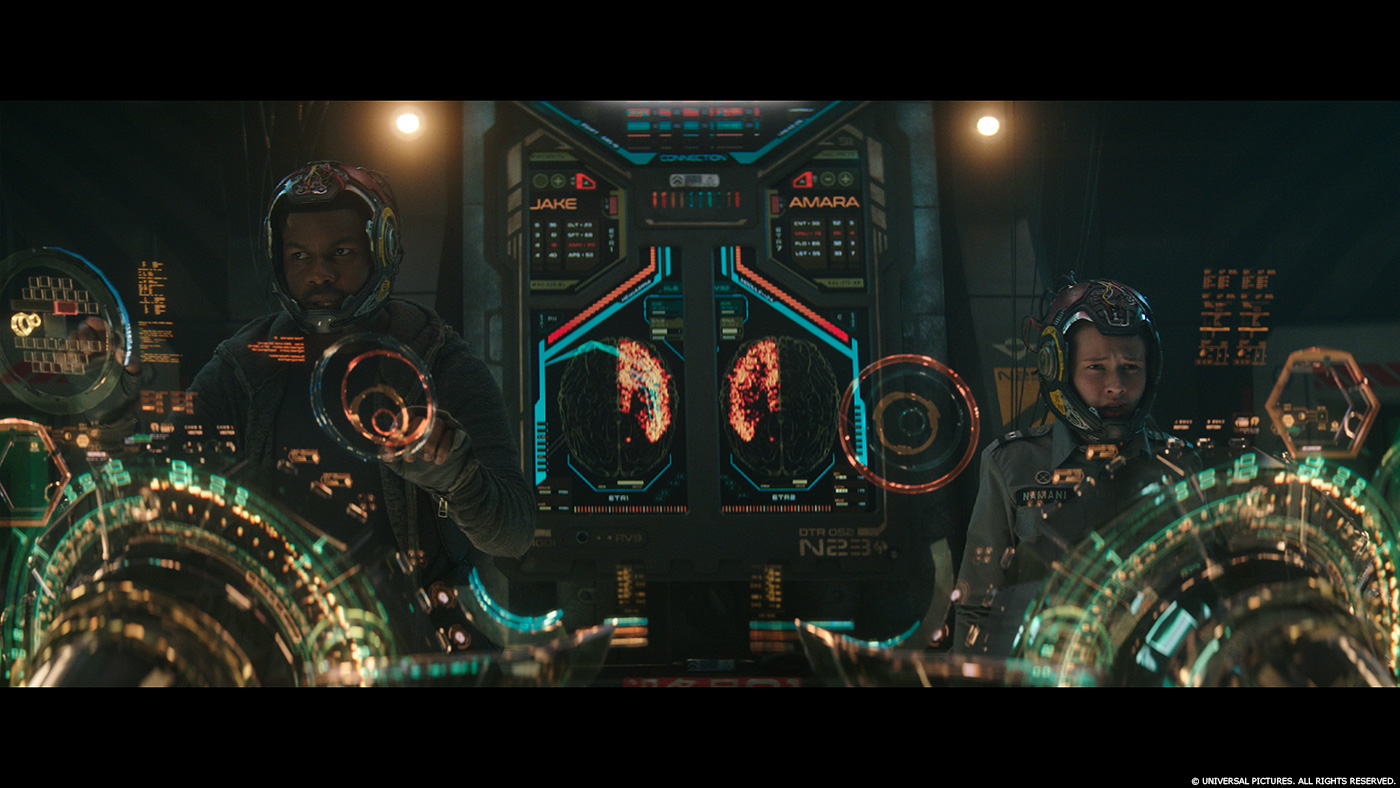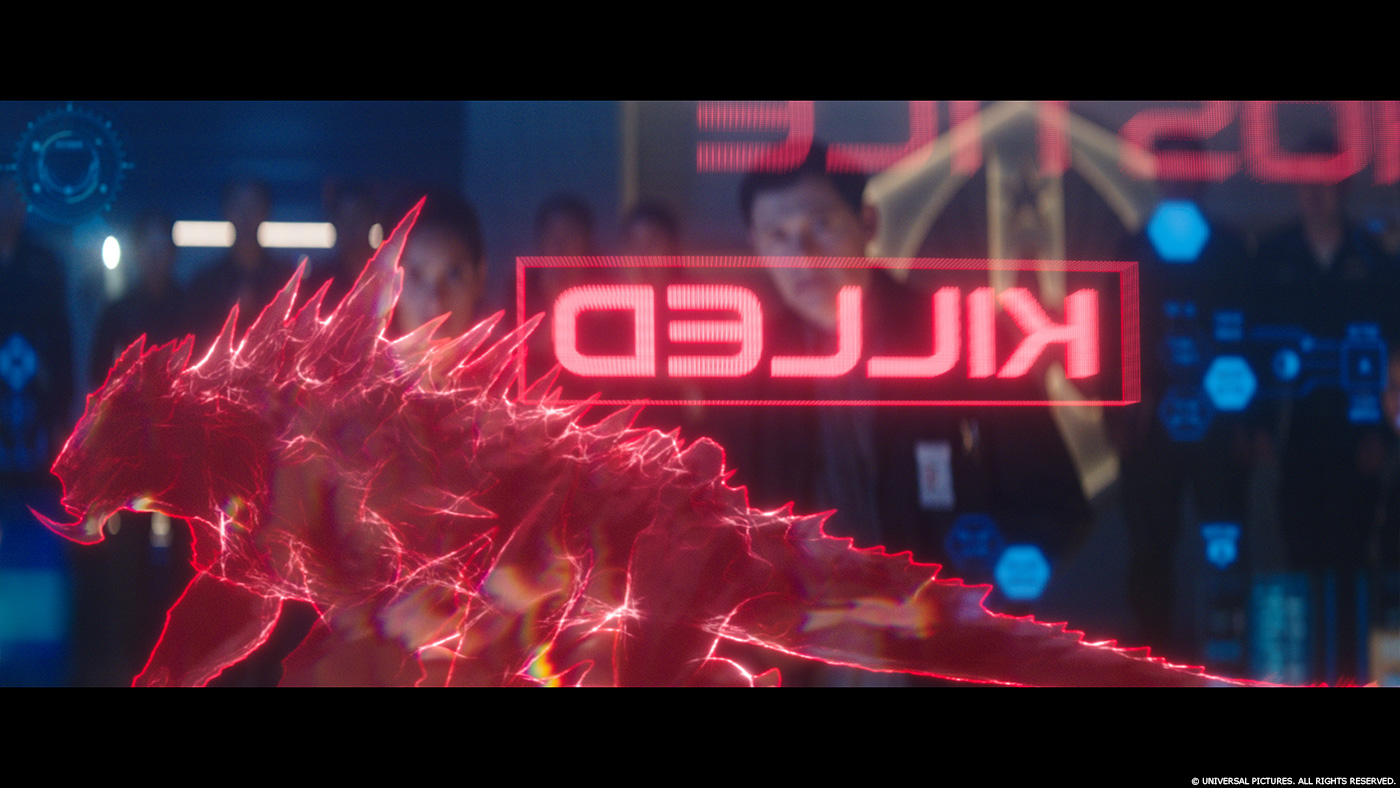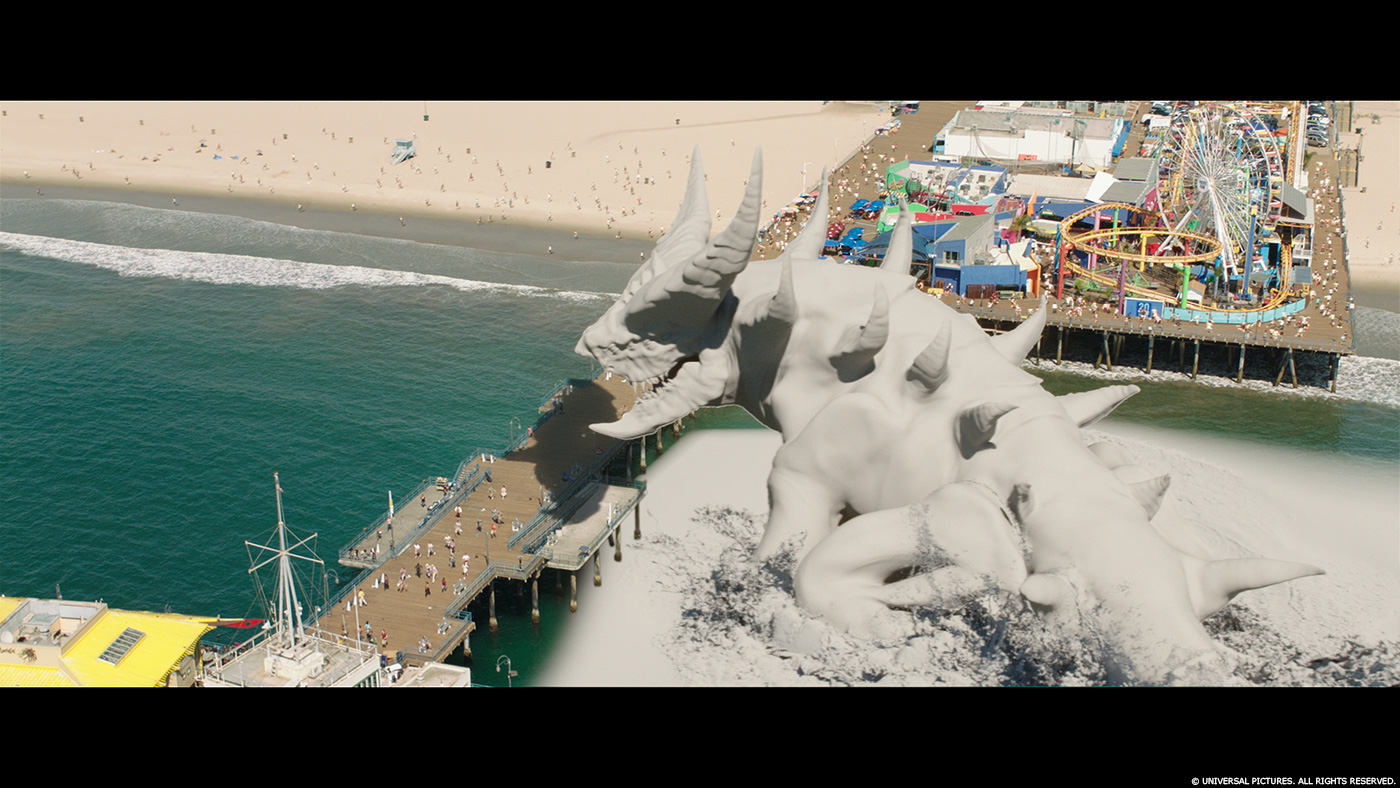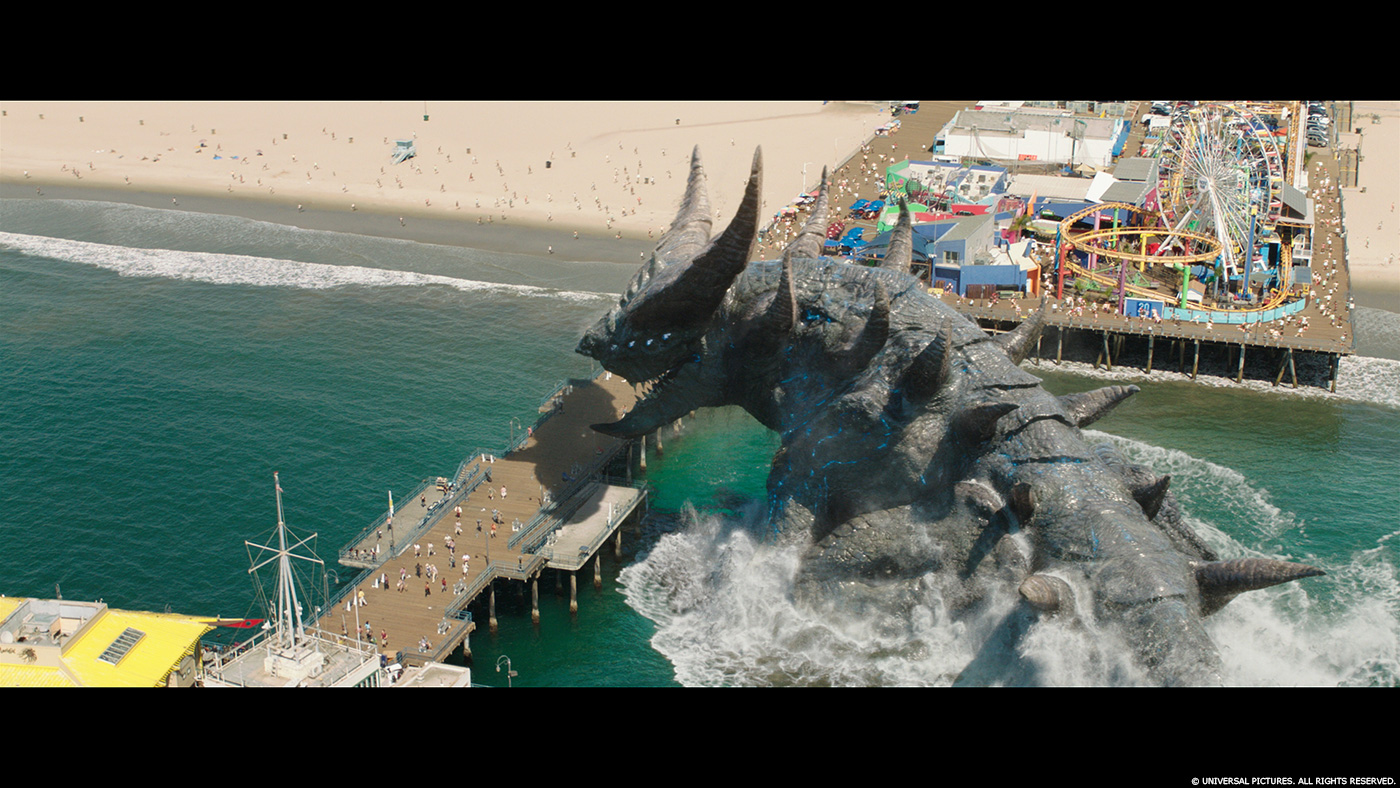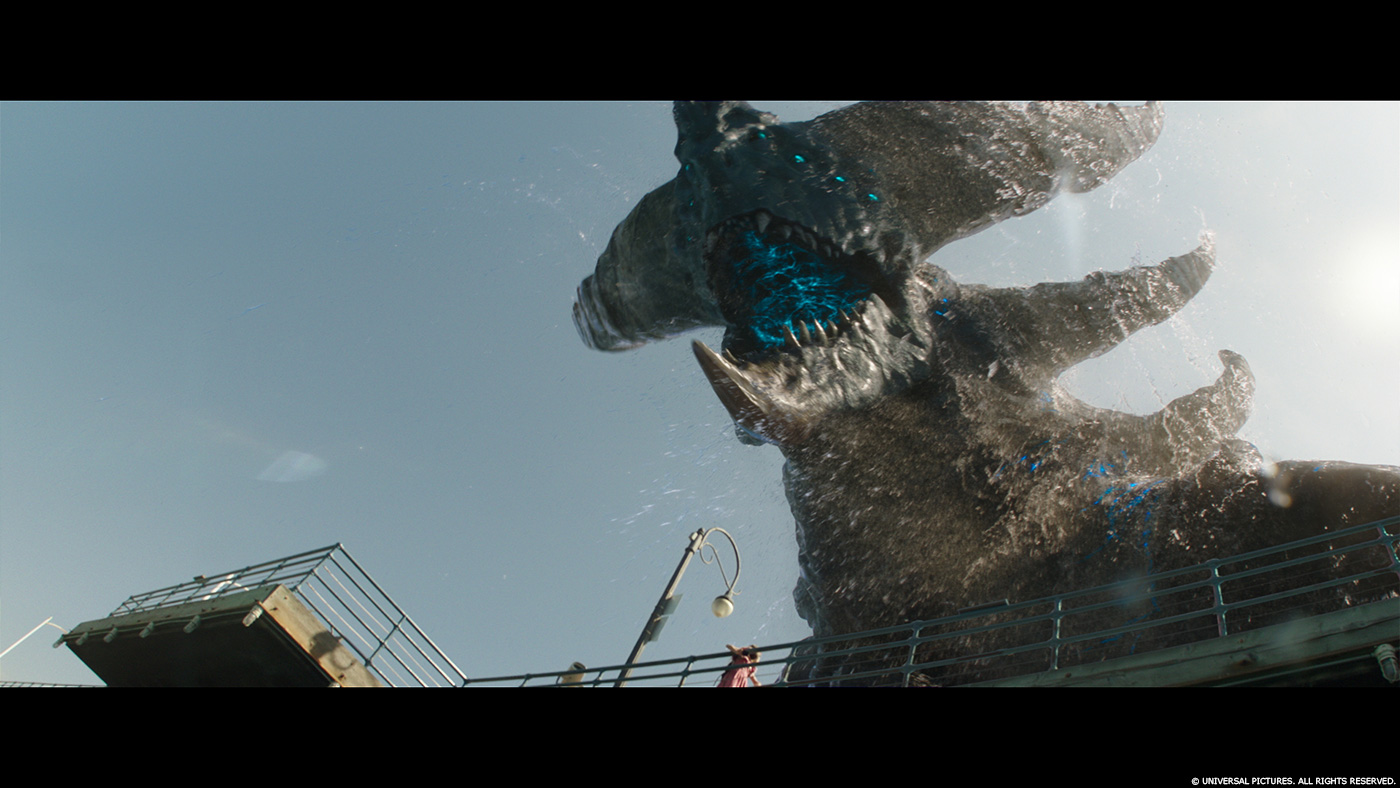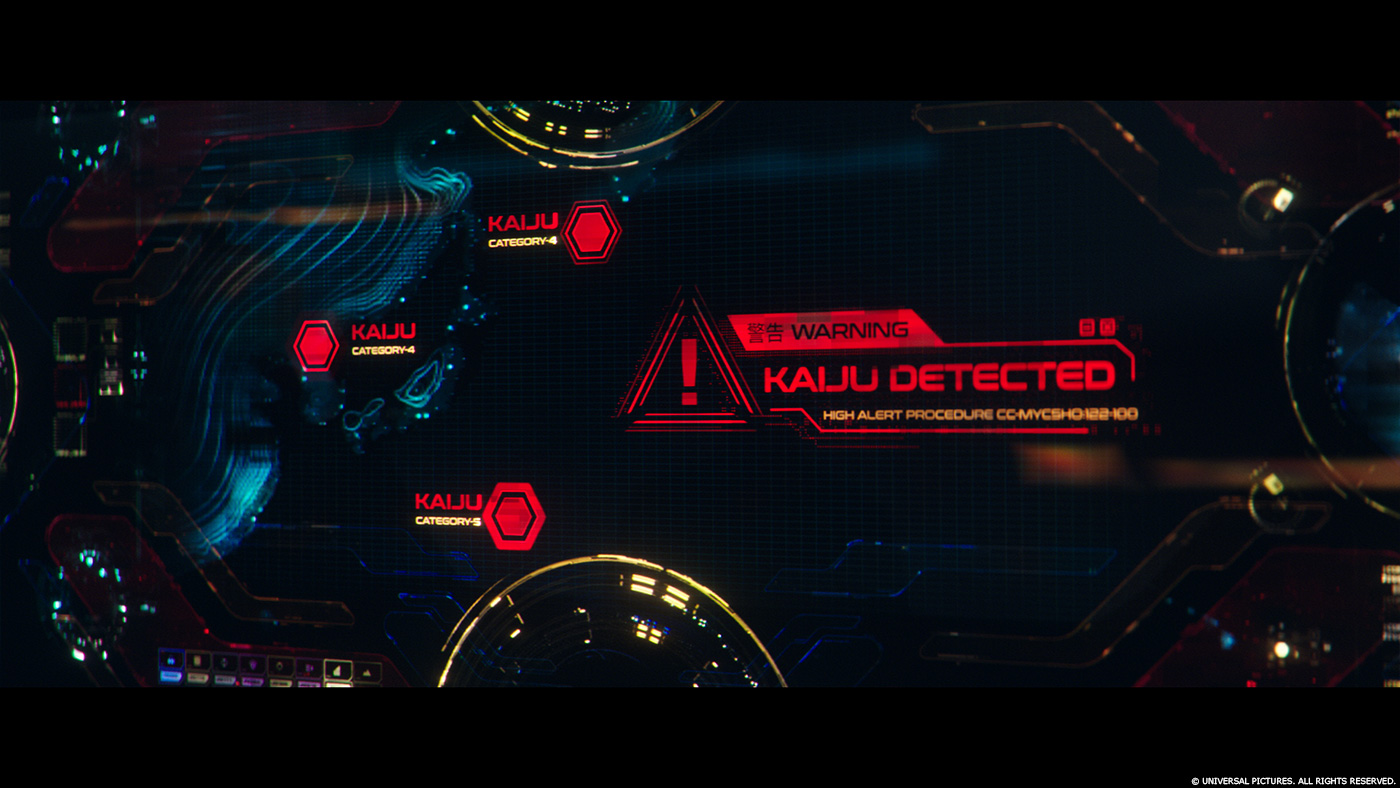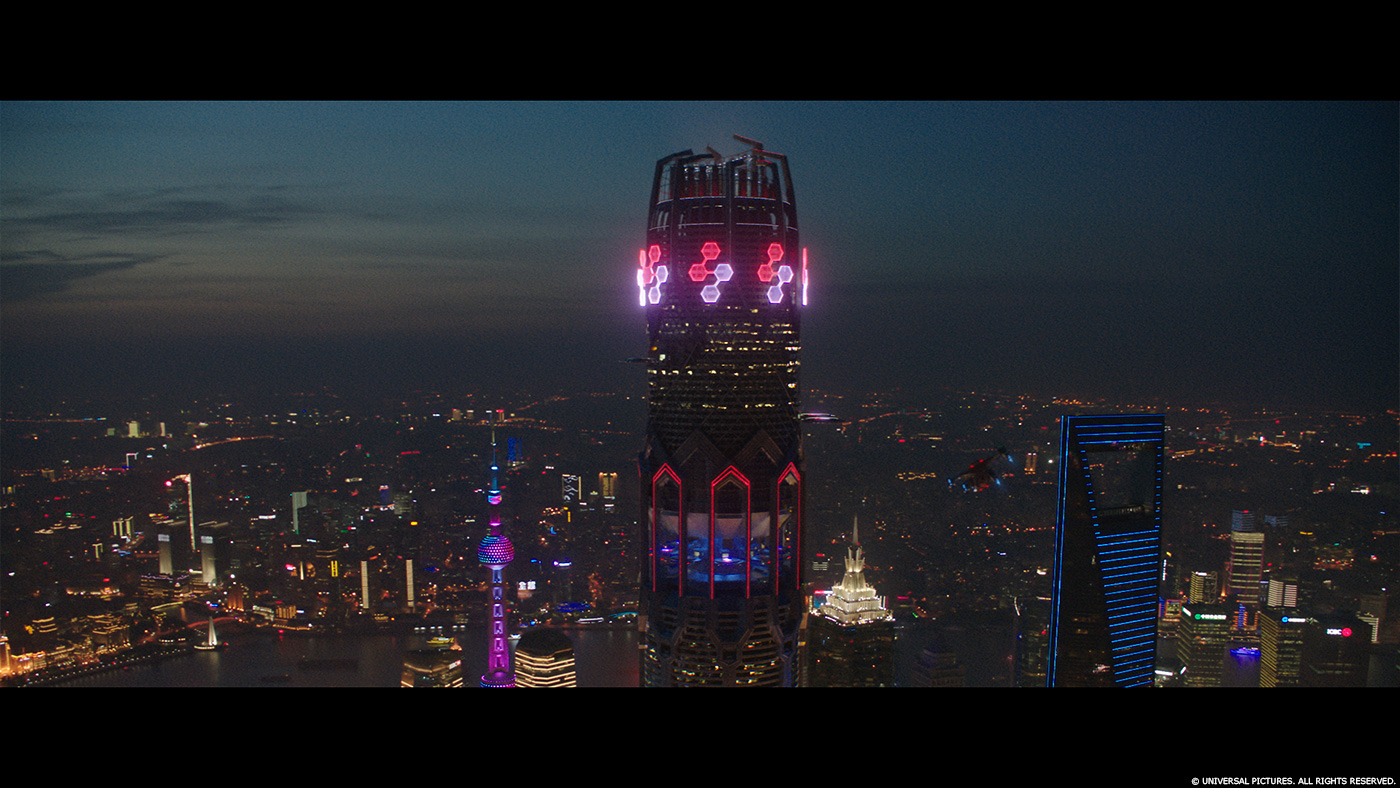Jedediah Smith joined Atomic Fiction in 2013 to work on STAR TREK INTO DARKNESS as a compositing artist. He then works on many films such as THE WALK, DEADPOOL, ALLIED and BLADE RUNNER 2049.
How did you and Atomic Fiction get involved on this show?
Atomic Fiction’s Partner/EP, Marc Sadeghi, and our team in Los Angeles have a great relationship with Legendary. We had also previously worked with Peter Chiang and Double Negative on STAR TREK BEYOND. When the workload expanded on the film, Legendary and Peter reached out to see if we wanted to join the project!
275 of these shots took place in the various war rooms, where we were tasked with adding holograms and screen content to aide in the storytelling.
We did 23 shots in the Santa Monica pier flashback sequence, where a Kaiju, code-named Sporkhead, emerges from the Pacific Ocean and smashes through the pier, killing Amara’s family in the process.
We had 22 shots in the final sequence in the movie where Jake and Amara have a snowball fight in the aftermath of the Mega Kaiju battle.
We also had an additional 10 shots in a flashback montage sequence where we added Kaiju bones and environmental destruction and enhancements. There were also a few shots of the Shao Industries tower, in which we replaced a real building from the plate with the Shao building, which we designed and rendered.
How was the collaboration with director Steven S. DeKnight and VFX Supervisor Peter Chiang?
Working with VFX supervisor Peter Chiang is always an amazing collaboration. On the hologram shots especially, we were given a large amount of latitude to design concepts and propose solutions to the creative challenges on the sequences. It was a great experience working under the expert guidance of Peter Chiang to bring the Kaiju sequences to life as well. The director Steven S. DeKnight did a great job keeping the creative direction in line and serving the storytelling.
What was their approaches and expectations about the visual effects?
The expectations for the visual effects work are of course high for any live-action feature film. Photorealism is always our goal regardless of where we end up at the end of the day. I think we were able to deliver a high level of quality on this show, despite the challenges.
How did you organize the work with director Steven S. DeKnight and VFX Supervisor Peter Chiang?
Atomic Fiction would have regular cineSync reviews with Peter, and once we had generated versions that were ready to show to the director for creative approval, they would be included in the director reviews. Towards the end of the show, as time was getting tighter, the director even sat in on a few of reviews in person.
Can you explain in details about the design and the creation of Sporkhead?
Atomic Fiction received the Sporkhead Kaiju asset from Double Negative for the Santa Monica Pier sequence. Our lead lookdev TD Jonathan Fleming-Bock worked to enhance the lookdev of the asset to really make it sing in the hero shots of the Kaiju breaking through the pier.
Some of the shots framed certain areas of the Kaiju very hero in frame. To get Sporkhead ready for its close ups, the character team created additional shot specific ultra high resolution sculptural detail. Jack Kim, our creature supervisor, worked on the displacement of the skin, referencing the callused folds of crocodiles and giant turtles, while still maintaining the otherworldly feel of the creature. We wanted to capture the growth and development process of the alien creature. Scales, claws, and horns all captured the tell tale signs of the creature’s massive growth and creation to give it a realistic sense of existence and physical presence in the world.
Can you tell us more about his rigging and animation?
Our character team built a rig for the Sporkhead character that allowed us to animate him convincingly in the sequence.
Many shots also had a pass of muscle simulation completed once the animation was finaled by the director, which added additional secondary animation details like muscle jiggle and fascia layers flexing over the skeletal structure of the creature. For each shot we wanted to maintain the illusion of rigid and softer tissue layered over regions of fatty build up, driven by the motion of the muscle mass, all flexing over a solid skeletal structure. For the wider shots, we created a muscle and skin simulation foundation using Ziva Dynamics. The results were then layered together with our in-house performance deformation techniques to create the final result.
Did you received specific indications and references for his animation?
We did reference various reptilian creatures for the Sporkhead’s appearance and movements. The Galápagos marine iguana was one of our references for movements, and we referenced alligator and giant turtles for the appearance and folds of the skin over the skeletal structure. Despite our references, the main direction was to make it look like a Kaiju though, so one of our big references was also the original PACIFIC RIM movie, and the beautiful VFX work on the Kaijus that was done there to establish the world.
How did you handle the massive size of Sporkhead with the animation?
Selling the size and scale of such a massive creature is always a challenge. Our Head of Animation, Marc Chu, expertly guided the movements of the creature, ensuring that it moved with convincing weight and mass. We also paid close attention to the pose of the Kaiju in the shots, trying to get a dramatic silhouette and an interesting composition.
For the wider shots especially, one of the things that helped us sell the scale of the creature was to add lots of high-resolution detail. The fine skin displacement texture was a good starting point. On top of this, we added an animated reflection map in the shader for the look of wet skin. This helped sell the fine detail of the Houdini fluid simulation of water droplets sheeting off of the creature. All of these small details might seem inconspicuous but they are super important in achieving a giant monster of convincing scale.
How did you created the various shaders and textures?
The textures for the Sporkhead asset came from the original work done by Double Negative. We have a Katana / RenderMan pipeline, and Double Negative has a Clarisse pipeline. Since our renderers are so different, we had to re-do the lookdev from scratch. Referencing lookdev turntables from Double Negative, we meticulously matched the look of the character in our rendering system. Using this as a starting point we then built on this lookdev to add displacement detail and sell the look of the wet Kaiju emerging from the ocean in broad daylight.
The Kaiju is seen on broad daylight. How did you manage this aspect for the lighting?
The lighting in the Santa Monica Pier sequence was very challenging, especially for the wide shots. Many of these shots were front lit with the sun basically behind the camera. This is one of the least flattering lighting conditions, since the light will flatten out any shadows to provide shaping and detail to the objects in front of the camera. Our lighting supervisor Christopher Ahrens and his team worked extensively on the lighting, trying to figure out how much we could cheat the light direction without breaking photorealism and achieving convincing integration of our Kaiju monster with the plate. Eventually, we arrived at a good compromise which added drama to the Kaiju, shaped his horns and muscles and skin displacement, while maintaining our ability to integrate him with the plate in the final composite.
There were a couple of shots where we had to cheat the light direction even more in order to keep the shadow of the Kaiju off of our heroes: Amara’s family. Since they were shot in direct sunlight it would have been impossible work in compositing to convincingly relight them as if they were in shadow. For these shots, we cheated the lighting direction so that the shadow landed just behind the family, and added additional shadowing from imaginary mist behind the camera, in order to sell the integration.
Can you tell us more about the inner light of the Kaiju?
Like many of the Kaijus, the Sporkhead creature has blood that is luminescent and emits a blue-green light. Sporkhead has this luminescence showing through in some patches on its skin, and in its eyes and mouth. Since this sequence was shot in direct sunlight, we couldn’t make the brightness of this bio-luminescence very noticeable, but we played it up in certain shots to make it more dramatic, for example in the first shot with the Kaiju roaring and spraying water everywhere.
How did you created the pier and the beach environment?
In the shots of the pier being destroyed by the Kaiju’s arm, the plates were shot with the area of the pier that would be destroyed taped off, so the actors had a reference point for where the edge of the chasm that opens up between Amara and her family would be placed.
We animated the Kaiju’s arms and legs swinging through the pier, sending broken wood and concrete flying. Rigid body simulations for the splintering wood and debris were done in Houdini by our FX team, and then passed to Katana for lookdev lighting and rendering.
Our assets supervisor Seth Cobb had an interesting muddy adventure climbing down under the Santa Monica pier so that we could accurately recreate the pillars, concrete structures, and boards on the underside of the top planks after the pier was destroyed. These details were carefully modeled, with careful attention paid to the lookdev. For example, if you look closely in some shots you can see pools of water on the top planks, broken concrete with a layer of algae on the non-fractured surfaces, we even added a broken water pipe underneath that is spraying out water in some shots.
The plates had many unconcerned sunbathing bystanders hanging out on the beaches in the background. Overseen by our rotopaint supervisor Tony Como, we meticulously removed these bystanders to enhance the storytelling.
Can you tell us more about the crowd creation and animation?
In a couple of the wider shots, we not only had to paint out the unconcerned bystanders in the background, but also replace them with a CG crowd simulation. Our character artist Hirofumi Kasagi pulled from a selection of character animations created in Maya, and developed a system to import these run cycles into Houdini. He also developed a “motion mixer” tool, which allowed us to add additional random variation to the crowd, by combining the animation of element A’s swinging arm and element B’s head, and element C’s other body parts for example. This let us build a crowd with more complexity and random variation, from a limited selection of source animations. The geometry caches were then passed to Katana for lighting rendering and lookdev.
How did you work with the SFX and stunt departments?
Unfortunately for the Santa Monica Pier sequence, there wasn’t much Special FX shot on set. We enhanced most of these plates in post-production, adding hanging mist in the air, falling raindrops from the massive Kaiju above the characters, and adding splashes and pier destruction FX.
For the close-up shots of Amara and her family, we added falling rain, sometimes with splashes on the pier, and blowing mist in the air, to enhance the drama of the sequence and sell the continuity of the monster moving above them.
The attack involved a lot of water simulations and destructions. Can you explain in details about these simulations?
The water simulations in the Santa Monica Pier sequence was particularly challenging. Lyubomir Kirkov, our FX lead on the sequence did an awesome job of bringing these water simulations to life. The ocean simulation in the wider shots consisted of two components: a Houdini flip fluid simulation for the water, and an additional particle simulation for the whitewater and spray.
The flip simulation was upwards of 5 billion particles, and the white water was an additional 2.5 billion particles after cleanup and pruning of particles outside the camera frustrum and other optimizations. Getting these FX simulations into lighting also proved a challenge. The wide shots with the ocean could only be rendered on our big blades with 376GB of ram. These simulations were heavy to calculate and were very difficult to render, but they ended up looking awesome.
Which sequence or shot was the most complicated to create and why?
Every sequence had its challenges, but the Santa Monica pier Kaiju shots were definitely the most complex to create. There were so many layered FX elements: ocean, splashes, raindrops, mist, breaking wood and debris, not to mention the menacing presence of a hero CG monster throughout it all. It was a big challenge to art direct all of these elements to work cohesively in the shot while selling integration and telling the story. This sequence was worked on by almost every department at the company, and the success of this collaboration speaks for itself: the shots look awesome.
What is your favorite shot or sequence?
I am most proud of our work on the Santa Monica pier destruction sequence. This sequence was a big step forward for our character and FX work. These were very complex shots and were very challenging to do in the tight schedule of this show. Despite all the challenges they came out looking great.
What is your best memory on this show?
The things I love most about my job are problem solving, and working closely with my awesome team of compositors.
Like most aspects of filmmaking, VFX is a very collaborative process. To make the shots as good as they can be, you need to be open to all suggestions from every level, and encourage close collaboration between artists and between departments.
Despite the crazy schedule and all the challenges on the show, my favorite memories are working closely with my team.
How long have you worked on this show?
Atomic Fiction received plates on September 21st 2017, and we delivered our last shot on January 25th 2018.
What’s the VFX shots count?
Atomic Fiction delivered 330 final shots, and the total number of shots we worked on was 357.
What was the size of your on-set team?
The on-set team consisted of Atomic Fiction Co-Founder and VFX Supervisor Ryan Tudhope, Assets supervisor Seth Cobb, and our Head of Animation, Marc Chu.
What is your next project?
I am currently comp supervisor on AD ASTRA.
A big thanks for your time.
// WANT TO KNOW MORE?
Atomic Fiction: Official website of Atomic Fiction.
© Vincent Frei – The Art of VFX – 2018


